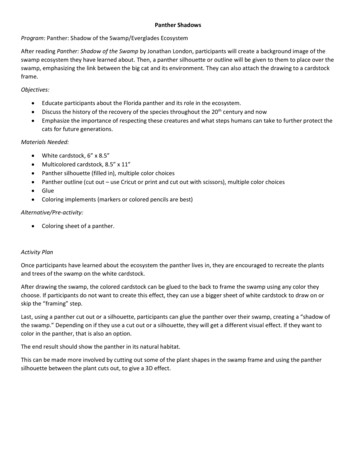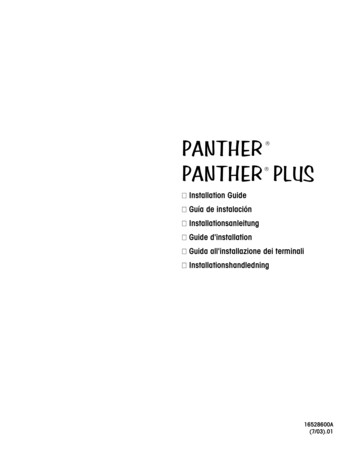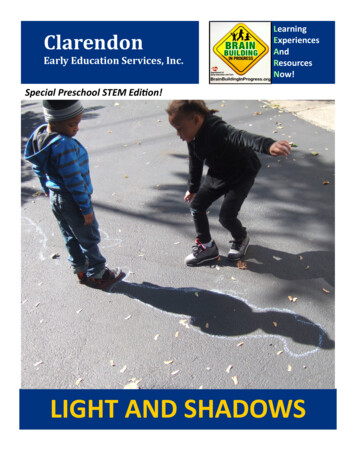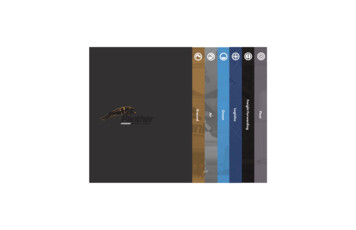
Transcription
Panther ShadowsProgram: Panther: Shadow of the Swamp/Everglades EcosystemAfter reading Panther: Shadow of the Swamp by Jonathan London, participants will create a background image of theswamp ecosystem they have learned about. Then, a panther silhouette or outline will be given to them to place over theswamp, emphasizing the link between the big cat and its environment. They can also attach the drawing to a cardstockframe.Objectives: Educate participants about the Florida panther and its role in the ecosystem.Discuss the history of the recovery of the species throughout the 20th century and nowEmphasize the importance of respecting these creatures and what steps humans can take to further protect thecats for future generations.Materials Needed: White cardstock, 6” x 8.5”Multicolored cardstock, 8.5” x 11”Panther silhouette (filled in), multiple color choicesPanther outline (cut out – use Cricut or print and cut out with scissors), multiple color choicesGlueColoring implements (markers or colored pencils are best)Alternative/Pre-activity: Coloring sheet of a panther.Activity PlanOnce participants have learned about the ecosystem the panther lives in, they are encouraged to recreate the plantsand trees of the swamp on the white cardstock.After drawing the swamp, the colored cardstock can be glued to the back to frame the swamp using any color theychoose. If participants do not want to create this effect, they can use a bigger sheet of white cardstock to draw on orskip the “framing” step.Last, using a panther cut out or a silhouette, participants can glue the panther over their swamp, creating a “shadow ofthe swamp.” Depending on if they use a cut out or a silhouette, they will get a different visual effect. If they want tocolor in the panther, that is also an option.The end result should show the panther in its natural habitat.This can be made more involved by cutting out some of the plant shapes in the swamp frame and using the panthersilhouette between the plant cuts out, to give a 3D effect.
Historical Research/Works Cited 1The Florida panther was listed as endangered in 1967 by the Department of the Interior, with a population inrapid decline from habitat loss and hunting. With habitat protection and the introduction of Texas cougar genesinto the Florida population, stability has returned to the small group but recovery is ongoing. 1The panther will continue to remain on the endangered species list until there are three separate, healthypopulations across the peninsula with over 200 cats per area. 2The Florida panther is taxonomically known as Puma concolor coryi, with Charles Barney Cory being the first todescribe Florida’s subspecies in 1896. Concolor is Latin for “one color,” that is, the panther’s adult coat is auniform tan or light brown in color.3 Scientific literature identifies between six and thirty subspecies of puma.4Smaller cats have elliptically shaped pupils because they hunt primarily after dark and their eyes can open widerto increase their night vision. Pumas have round pupils, making hunting effective during the day possible aswell.5Panthers cannot roar. They do not have the small piece of cartilage at the base of their tongue to do so. Bobcats,cheetahs, lynx, and domestics cats also cannot roar. 6Spanish explorer Cabeza de Vaca, the treasurer for the Narvaez expedition to La Florida in 1527, describedseeing a “lion” on their journey through Southwest cts.https://www.floridapanther.org/panther-facts; https://www.fws.gov/refuge/florida panther/wah/panther.html3“Physical Description,” wildlife/panther/description/5“Physical Description,” r/description/6“Physical Description,” r/description/7”What’s in a Name?”, r/description/2
Florida Panther (Puma concolor coryi)Instant ID A large cat, weighing as much as 160 poundsSolid tawny-colored body with a white mouth, pink nose and blacktipped tailYoung have spots, which fade within the first six monthsNative Niches Formerly found throughout Florida and seven other statesHighly adaptable to any land habitat, but now limited to the forestsand swamps of South FloridaFewer than 170 panthers remain in the wildFavorite Foods Usually eats deer and feral hogs, however will eat smaller prey
Florida Panther (Puma concolor coryi)Critter Characteristics Capable of killing prey larger than itselfDesignated Florida’s state animalMore closely related to a housecat than a lionA subspecies of the puma, also known as painter, catamount,mountain lion and cougarPopulation Protection Overhunting and habitat loss led to the panthers’ listing as anendangered speciesProtect wild spaces to keep panthers around for future generationsCollisions with vehicles cause the most panther deaths, observepanther crossing signs and posted speed limits
Florida Pantherwww.FloridaStateParks.org#FLStateParks
Smaller cats have elliptically shaped pupils because they hunt primarily after dark and their eyes can open wider to increase their night vision. Pumas have round pupils, making hunting effective during the day possible as well.5 Panthers cannot roar. They do not have the small piece of cartilage at the base of their tongue to do so.










